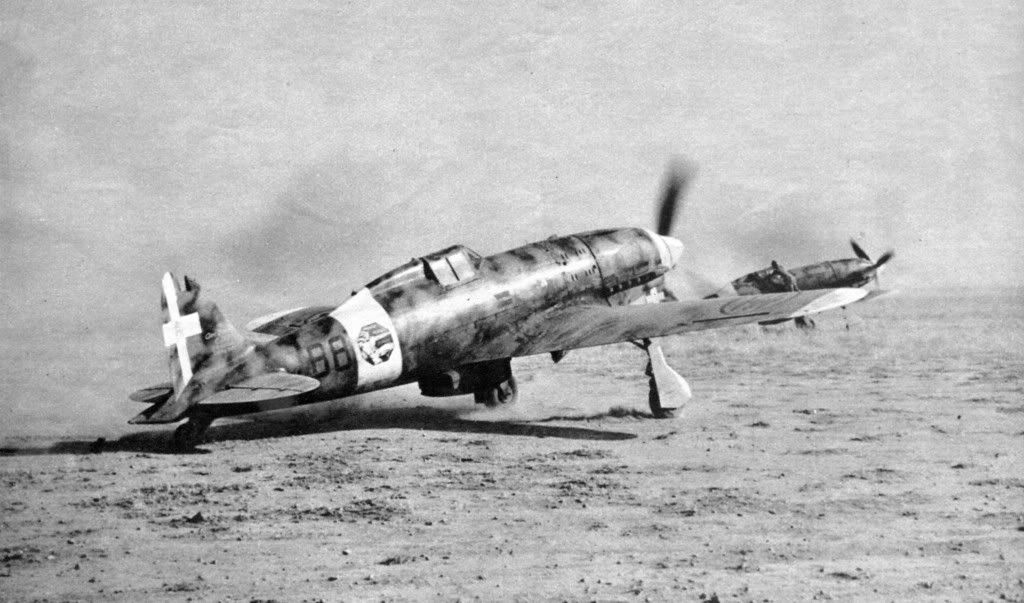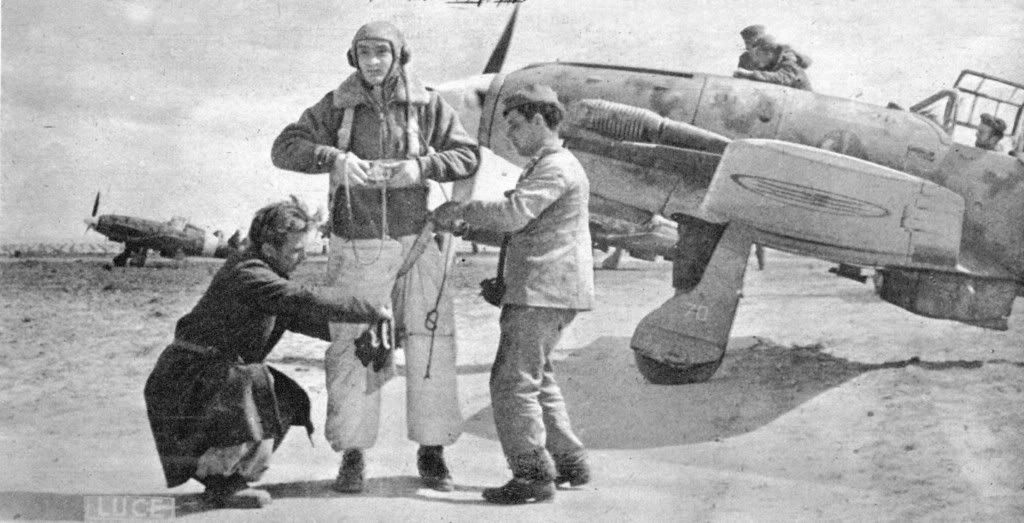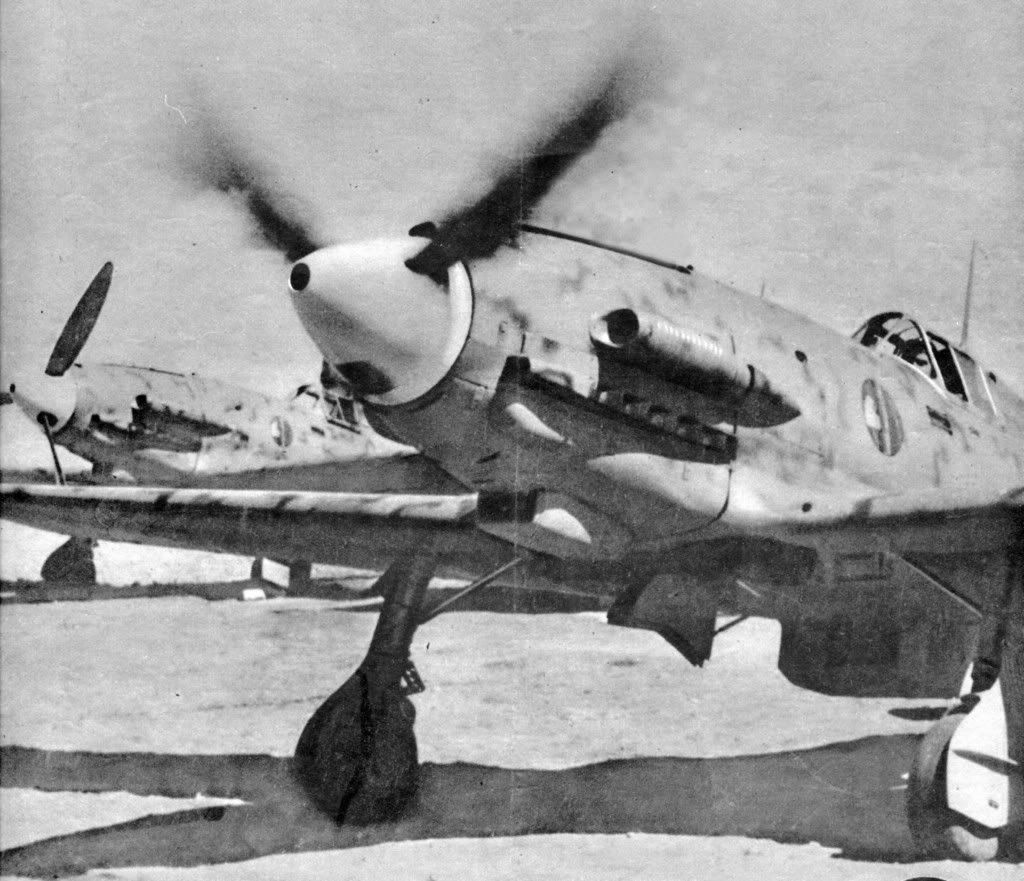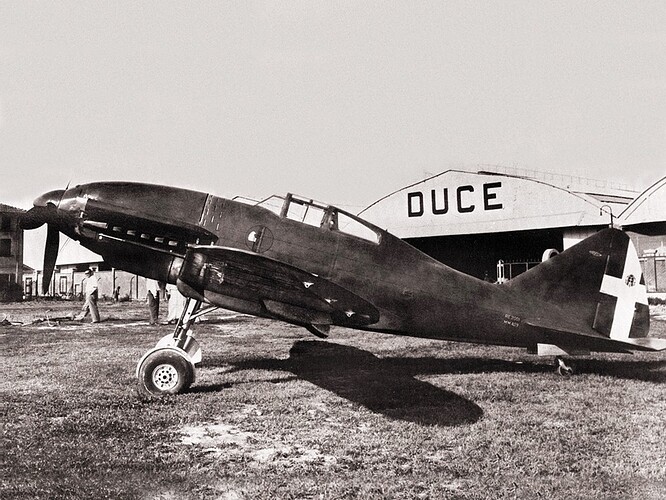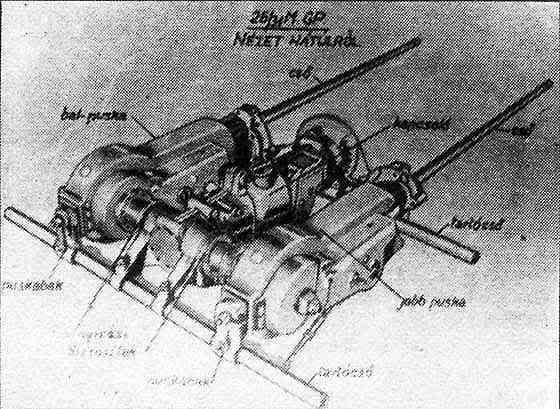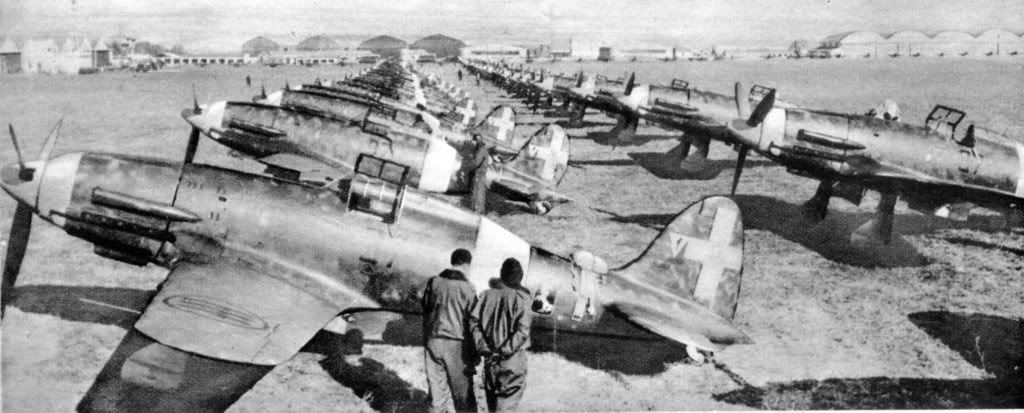A nice overview courtesy of ww2wings.com
[b]THE ITALIAN AIR FORCE IN WORLD WAR II
BACKGROUND[/b]
The story of the Italian Air Force in World War II is really three stories. The first is the story of the Regia Aeronautica, the Royal Air Force, from the invasion of Ethiopia in 1935 until the Armistice of September 1943. The second chapter is the story of the Aeronautica Nazionale Republicana (ANR), whose pilots represented the newly formed Republica Sociale Italia (RSI) puppet government and flew with the Luftwaffe after the Armistice. Finally there is the story of the Italian Co-Belligerent Air Force (ICBAF), whose pilots flew with the Allies after the Armistice.
Italy was a reluctant participant in Southern Europe during World War I on the side of the Allies and did not suffer the economic and political hardships that the Treaty of Versailles imposed on Germany. The Regia Aeronautica (RA), was established in 1928 with 1700 planes and a vigorous aviation industry. Italian airplane manufacturers, dominated by industrial giant Fiat, were strongly committed to the air-cooled engine. They believed them to be more reliable and less prone to combat damage than water-cooled engines, notwithstanding the limitations that design imposed on power. Air-cooled engines meant minimal power and minimal power meant minimal defensive weapons, minimal bomb carrying capacity and no protection from armor plating. In the early years, Italian-made airplanes were generally not equipped with any type of radar or radio communications system and thus needed daylight and good weather conditions in which to operate.
taly invaded their former African colony of Ethiopia on October 3, 1935, and their planes, tanks and troops dominated their nearly defenseless enemy. Following the Ethiopian incursion, Mussolini sent 660 planes and 75,000 soldiers in October of 1936 to aid the Nationalist movement of Francisco France at the outbreak of the Spanish Civil War. The Regia Aeronautica, outfitted with generally inferior and consistently underpowered airplanes, gave a mediocre performance in Spain.
…
THE ROLE OF THE REGIA AERONAUTICA 1940-1943
Italy entered World War II on June 10, 1940 with a declaration of war against France. The German Blitzkrieg in Western Europe was well underway and the outcome in France was not in question. The RA was involved in reconnaissance flights in Southern France and a number of attacks on French airfields. The French surrendered on June 24. The two week war wasn’t much of a test for the RA.
Several squadrons of the Regia Aeronautica based in Belgium took part in 150 bombing raids over England during the Battle of Britain beginning in October 1940. The first major operational effort of the Italian Air Force took place in the Balkans (Greece, Yugoslavia) during the period October 1940 until April 1941. The Allies had a distinct advantage since their planes contained the electronic equipment that allowed them to operate in bad weather and at night. The RA’s role was primarily one of close ground support.
July and August of 1941 saw units of the Regia Aeronautica flying in Russia in support of 60,000 Italian ground troops fighting in Operation Barbarossa. Not surprisingly, mediocre airplanes, steady bad weather and the Russian Winter, combined to minimize the impact of the RA on the Eastern Front.
By far the major role played by the RA was against the RAF and the USAAF in the Mediterranean area. Malta, North Africa, Sicily and Italy were the sites of frequent encounters between the RA and the Allies. The British were required to resupply their forces in the area mainly by sea. This gave the RA a regular inventory of naval targets as late as mid-1943. In fairness, both Italian and German operations in the Mediterranean were often compromised as a result of the Ultra decrypts of Enigma radio traffic. In general, the Regia Aeronautica fared poorly in its encounters with Allied forces and was not a significant factor in the war.
THE SIGNIFICANCE OF THE ARMISTICE
Sicily was invaded by the American and British armies on July 10, 1943 and evacuated by the German and Italian forces barely 5 weeks later. The handwriting was on the wall for the Italians. Italy was obviously the next target. The fascist government of Benito Mussolini collapsed on July 25, 1943 with his resignation and subsequent arrest. The new government was quick to negotiate an unconditional surrender. The Armistice was signed on September 3, and announced to the public 5 days later as the American 5th Army was wading ashore on the Italian mainland at Salerno just south of Naples. The agreement required the Regia Aeronautica to transfer all airplanes to Allied airfields. This was particularly difficult since most of the Italian peninsula was occupied by heavily fortified German positions and fierce battles were going on in southern part of the country. To make matters more confusing, Mussolini had been rescued by German paratroopers on September 12, 1943, and Hitler had installed him as the head of a puppet government, the Republica Sociale Italiana (RSI) in the Northern part of the country. Not surprisingly, some pilots decided to head North and fly with the Luftwaffe while others headed South and joined the invading Allies. Who decided to go where was not simply a matter of politics or loyalty to a cause. It had as much to do with where the units were located at the time of the Armistice and, more importantly, where the pilot’s family was located within the country. Two separate air forces came into existence after the Armistice, each structured along the lines of their respective allies (the Luftwaffe in the North and the USAAF and the RAF in the South). The atmosphere was reminiscent of a civil war.
THE AERONAUTICA NAZIONALE REPUBLICANA
Those Italian pilots from the Regia Aeronautia who went North to fly for the Luftwaffe were called the Aeronautica Nazionale Republicana (ANR). While trying to maintain a separate identity from the Luftwaffe, they quickly adopted the German ways of doing things. The ANR was made up primarily of three fighter groups with three squadrons each (approximately 200 pilots). The ANR’s primary mission was to repel attacks of medium and heavy bombers of the 12th and 15th Air Forces. Since many industrial targets in Northern Italian cities were being attacked regularly after September 1943 by bombers of the USAAF and the RAF, the bulk of the activities of the ANR were mainly defensive in nature. Gradually the Germans began to equip the ANR with Messerschmitt Bf-109s to replace the inferior Italian-manufactured planes. In August of 1944, the Germans, disappointed over the performance of the ANR, attempted to officially disband the organization and take over their equipment and personnel. Some ANR pilots staged an armed rebellion and set fire to their planes rather than surrender them to the Luftwaffe. Faced with this unexpected reaction, the Germans backed off, reassessed their position, rescinded the order, and sent a new Luftwaffe commander to Italy. The Germans and the Italians didn’t get along particularly well before the attempted “coup” and the relationship did not improve afterwards. The Italians never shared the Germans’ strong feelings about their cause and their intensity for organizing and managing. On the other hand, the Germans viewed the Italians as not particularly motivated pilots, with marginal skills and inferior equipment, and, from whom minimal results could be expected. Predictably, the ANR was plagued by chronic fuel and spare parts shortages with the bombing of aircraft factories and railways in Northern Italy. The ANR ceased to function at all in early 1945.
THE ITALIAN CO-BELLIGERENT AIR FORCE (ICBAF)
Following the Armistice, 203 planes of the Regia Aeronautica made their way to Allied airfields including 39 fighters, 117 bombers and assorted transports, seaplanes & torpedo bombers accompanied by a substantially larger number of crews. The number grew to 281 by the end of the year. Of these, only 165 were in flying condition. Many of these planes were technically obsolete compared to the planes of the USAAF and the RAF. After being re-equipped with Allied planes, the ICBAF engaged in transport, escort, reconnaissance, sea rescue and limited tactical ground support operations in the Mediterranean theater of war. These pilots flew over 11,000 missions in the final 18 months of the war. The ICBAF was later renamed the Aeronautica Militare Italiano (AMI). While deliberately maintaining a low profile in Italy, their contributions to the war effort were primarily in support roles.
Other links:
http://www.comandosupremo.com/Air.html
http://www.ww2wings.com/wings/italy/italymain.shtml
http://www.ww2aircraft.net/forum/old-threads/regia-aeronautica-163.html





